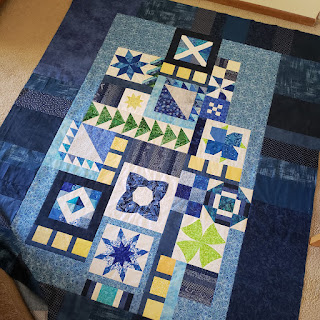In Thursday's post I shared the start of the pieced backing for my Sliding Screen quilt. If I have time to spare, I like to use up scraps in a pieced quilt back. It's a fun, low-pressure and low-stress creative exercise. If it doesn't turn out as well as I'd hoped, it's mostly hidden on the back so no worries.
This time around I'm very happy with how it turned out. I think I like it more than the top. Oops!
With that in mind, I decided to send the quilt out to be quilted with an all-over design that will play well on both sides. I had planned to quilt it myself, but I'm not great at the style of all-over design that would look good on both sides. The custom quilting I would have done instead on the top would look odd with the piecework on the back so the quilt wouldn't really be reversible.
------------------------------------------------------------------------------------------
Here's a bit more info about how this backing came together.
Many of my pieced backs start with one length of yardage the desired length of the backing. I add a pieced strip down the length of the back. This makes the most sense when the backing will be less than 1 1/2 times the width of fabric (WOF). This lets me buy half the yardage I would have to buy otherwise, and allows me to use up scraps from the top.
In this case, I didn't have any yardage long enough to span the length of the quilt, so I built some from smaller WOF cuts. The different fabrics were all slightly different widths. I could have just sewn them together, then straightened the resulting ragged side, then sliced the whole thing down the length.
I actually find trimming long uneven edges to be a bit of a chore, so I chose to cut two segments from each piece of yardage then sew them together into two separate columns. I could cut a 15" segment and and a 25" from the narrowest yardage, so those are the measurements I used for all the fabrics. I matched centers and ends and pinned before sewing to keep the columns straight. Note that one column is wider than the other, so that the improv pieced strip would look purposefully off-center. I didn't want my longarm quilter to have to fuss about centering the top perfectly over the back to center the pieced middle column on the back.

Notice the wide plain panels at the top and bottom of the pieced center strip. Those were planned so my longarmer wouldn't have to fuss about centering things top to bottom either. Whether the quilt is loaded with more or less extra backing at the top, the top and bottom edges of the quilt top will fall somewhere within the dark brown plain panels, rather than ending up with a panel at one end, and cut off piecing at the other.
Piecing the center strip was a fun exercise in slab piecing. I didn't measure anything. I just sewed two pieces together, then trimmed a side straight before adding another piece.
 |
| Longer strip sewn to pieced section. |
 |
| After trimming away excess |
If I didn't have a piece long enough to span the side of the previously pieced bit, I sewed scraps into a longer strips until I had a new piece that was long enough.
I just kept adding scraps until I had panels the width I wanted. If they turned out a little wider because of the size of the scraps, I just trimmed the panels down to size. I needed the backing to be about 63" wide. The side columns accounted for 39.5" (40" minus seams where the center will be sewn in) and vertical strips between the side columns and the scrappy center column to set off the pieced section a bit added 4". With that in mind, I pieced the panels to be 20" wide, to finish at 19" wide.
Before I sewed the pieced column between the two side columns, I toyed with the idea of slicing the pieced column at an angle in a few places to insert some light strips. I laid some strips across the panels to audition what that might look like.
I left everything on the wall overnight before slicing, because if I sliced, I couldn't change my mind! Coming back to it all with fresh eyes in the morning, I decided the angled slashes would be more work for no added benefit, so I left them out.
The last step before sewing the columns together was to trim the center column to the same length as the side ones. I laid the columns one on top of the other to measure and mark directly on the fabric, skipping measuring tapes.
Voilà, one pieced quilt back, nice and flat and square. Well rectangle, but straight and with square corners :)
I dropped off the quilt top and backing for quilting yesterday and will have it by the end of next week. Next task: make the binding, also with scraps from my stash.
I'd love to hear if you make pieced backs. Why and how and how often?
Happy quilting


















































.jpg)

.jpg)


